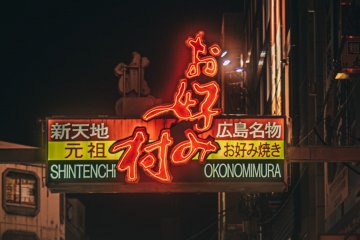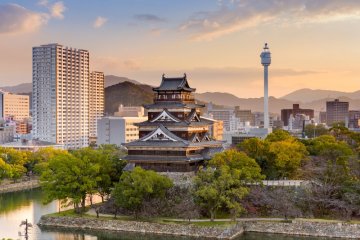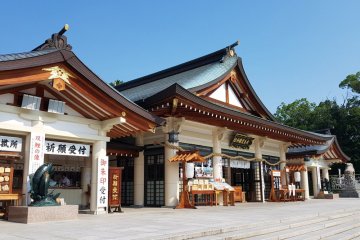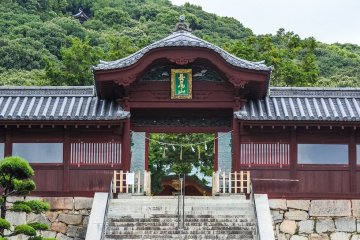
L'Auberge J-Hoppers à Hiroshima
Geraldine BartoliJ-Hoppers, l’une des auberges de jeunesse les moins chères et les plus agréables que vous puissiez trouver à Hiroshima !

Shukkeien Garden, located in central Hiroshima City, is a traditional Japanese-style garden loved by visitors and locals alike. This natural oasis among urban life provides a wonderful setting to slow down and rejuvenate among nature.
Admission is free on Greenery Day (May 4th) and Culture Day (November 3rd).
Shukkeien Garden was completed in 1620 as a private garden for one of Hiroshima’s feudal lords (daimyo) and translates to “shrunken scenery garden” in Japanese. Although the garden was severely damaged in 1945 during WWII, it was completely restored to its former grandeur and is known as a National Place of Scenic Beauty.
The Edo-period garden is cleverly landscaped to look like miniature mountains, valleys, rivers, bamboo groves, waterfalls, and forests. In the center of the garden, a carp-filled lake features multiple pockets of land that resemble islands. Plants pruned to look like tiny trees sprout from these islands and decorate the surrounding grounds. The pond’s stillness creates a mesmerizing reflection of the area’s natural hues and organic forms. The scenery shines brightest in springtime when the cherry blossoms are in full bloom, and in autumn when the foliage turns vibrant.
The garden also has a small stone statue on its northern side to commemorate the people lost during the atomic bombing in 1945.
You can view the expertly crafted scenery from a path around the perimeter of the park or in one of the garden’s many tea houses, which hold tea ceremonies year-round.
Shukkeien Garden is about a 15-minute walk from Hiroshima Station. From Hiroshima Station, you can also take the Hiroshima Sightseeing Loop Bus to the garden (5 mins) or the tram to the Shukkeien-Mae Stop, which is a short walk to the garden (15 mins total).

J-Hoppers, l’une des auberges de jeunesse les moins chères et les plus agréables que vous puissiez trouver à Hiroshima !

Okonomimura est un parc à thème gastronomique dédié aux okonomiyaki d'Hiroshima, plat très répandu au Japon et situé près de l'extrémité est de la rue commerçante Hondōri à Hiroshima. On y trouve 24 restaurants d'okonomiyaki, chacun avec un style et une sélection d'ingrédients légèrement différents L'okonomiyaki est proche du "Issen Yoshoku" ("repas occidental à un centime"), un plat populaire auprès des gens ordinaires pendant l'ère d'avant-guerre. Il se composait d'une pâte de farine cuite avec des oignons, des crevettes séchées et des épices. Après la guerre, d'autres ingrédients tels que le chou, les œufs, les fruits de mer, le sarrasin et les nouilles de blé ont été utilisés pour améliorer l'alimentation en ces temps difficiles. C'est ainsi qu'est né l'okonomiyaki dans la ville d’Hiroshima. [Photo: Victor Lee / CC BY-NC-ND 2.0]

Le château d'Hiroshima (広 島 城), également connu sous le nom de château de la Carpe, a été construit à l'origine en 1589. Il a été détruit par la bombe atomique avec le reste de la ville en 1945 et a été reconstruit en 1958. Depuis lors, il a également servi de musée pour l'histoire d'Hiroshima avant la Seconde Guerre mondiale. L'histoire du château lui-même, ainsi que des châteaux japonais en général, est relatée de façon intéressante. Le château d'Hiroshima est un bon exemple de château construit sur une plaine au centre d'une ville, par opposition aux châteaux sur les collines et les sommets des montagnes. Sa tour principale est haute de cinq étages et son parc est entouré d'un fossé. Dans le parc du château, on trouve également un sanctuaire, des ruines et des bâtiments Ninomaru reconstruits (deuxième cercle de défense).

Located on the grounds of Hiroshima Castle, Hiroshima Gokoku Jinja (広島護国神社) is a Japanese Shinto Shrine in central Hiroshima City. "Gokoku" Shrines are Shinto shrines designated as places of worship for those who have died in war. Like the controversial Yasukuni Shrine in Tokyo, what became Hiroshima's Gokoku Shrine was also originally constructed in 1868 to commemorate the Hiroshima Han victims of the Boshin War. Seventy-eight souls were enshrined in the Futabanosato shrine, named Mikureisha (水草霊社). Eventually, the total number of souls enshrined there reached 92,700, including the soldiers from the former Aki no kuni (now western Hiroshima Prefecture) who died in Japan's wars up until the start of the Great East Asian War (as World War 2 post Pearl Harbor is known in Japan) and around 10,000 workers and volunteer corps who were stationed in Hiroshima and lost their lives to the A-Bomb. In 1934 it was dismantled, rebuilt and renamed Kansaishoukonsha (官祭商塊社), and moved to a corner of the west of the military parade ground, where the Hiroshima Municipal Baseball Stadium stood until the end of 2008. In 1939, its name was changed by order of the Interior Ministry to the Hiroshima Gokokujinja. In 1945 it was destroyed by the atomic bomb, and was rebuilt on the current site within the grounds of Hiroshima Castle in 1956 with the aid of donations from the citizens of Hiroshima. The current main building is even more recent, rebuilt in 1995, when the grand stone slab approach was also added. Events at the shrine are held throughout the year.

Hiroshima Tōshō-gū (広島東照宮) is a Shinto shrine in Hiroshima which was established in 1648. As with all Tosho-gu shrines in Japan, it enshrines the first Shōgun of the Tokugawa Shogunate, Tokugawa Ieyasu.